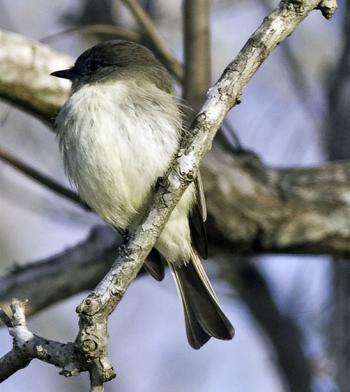Phoebe in the ’Hood
We are lucky this year. Unlike many people, we usually only have eastern phoebes in our yard and neighborhood during migration. But this late spring and early summer (and even this morning) we have awoken each morning to the exuberant “fwee-bee” song of a phoebe repeatedly echoing around our street.
Eastern phoebes (there are also several other species of phoebe that occur in the western U.S.) are named, as you likely suspected, after their song. They are one of the more beloved songbirds of the eastern U.S. and Canada because they nest most commonly on human-made structures including often under the eaves of sheds, garages, and houses but also on bridges and other structures. Before Europeans first came to the New World and began making buildings, phoebes probably nested mostly on cliff faces and rocky ledges, and a few still do.
Apparently in some parts of the U.S., phoebes have been commonly referred to as “barn pewees” and “bridge pewees,” the pewee part of the name equating them with their forest-dwelling cousins, the eastern and western wood-pewees. In fact, eastern wood-pewees are probably the species with which eastern phoebes are most confused. Along with some fieldmark differences that you can check out in our book Maine’s Favorite Birds, the timing of their arrival is one of the best ways to tell them apart. Phoebes are the earliest flycatcher to return each spring, sometimes showing up even by mid- to late March, while the similar-looking pewee doesn’t get back until late May. That difference is partly because eastern phoebes winter in the southeastern U.S. while eastern wood-pewees winter down in South America. And unlike phoebes, pewees stay in the thick woods, not necessarily near openings around homes and backyards.
Phoebes are members of the flycatcher family. Like other members of that family, they are almost wholly reliant on insects for food, although not just the dipterans (the “fancy” name for the flies). One study found that the bulk of the insects phoebes had eaten were actually insects in the wasp and bee family. In hard times, particularly during migration and winter, phoebes have been found to occasionally eat small fruits and berries and apparently even small fish, though instances of them partaking of this latter food source must be quite rare.
Unlike birds such as sparrows and warblers, phoebes (and indeed all flycatchers) do not learn their songs but are born with the ability to sing it. In experiments, researchers raised young phoebes in the lab where they had never heard another phoebe song. Sometimes they regularly heard other bird songs, yet the young phoebes all would sing only renditions of phoebe songs.
Phoebes are also famous for being the first North American bird species that was ever banded. And by none other than John James Audubon who in 1804 tied some silver thread to some phoebe nestlings near where he was living in Pennsylvania. The next year he found that several of the birds, which had become adults, had returned.
We are not sure where our neighborhood phoebe is nesting, although we know it is not in our yard, but we are just grateful to be graced with the familiar and wonderful song of the phoebe every morning!






























.png)
.png)

